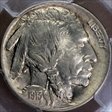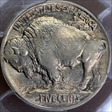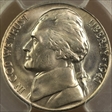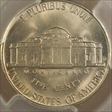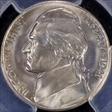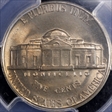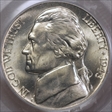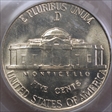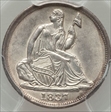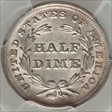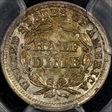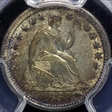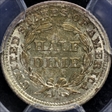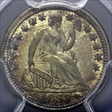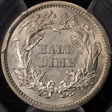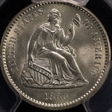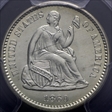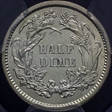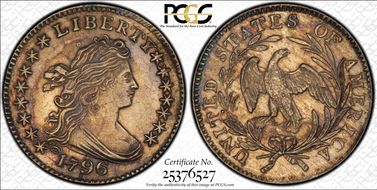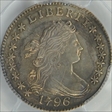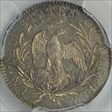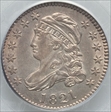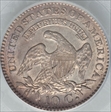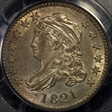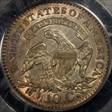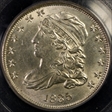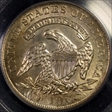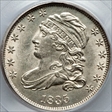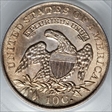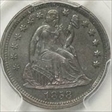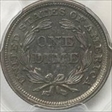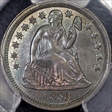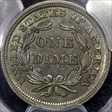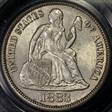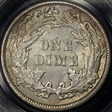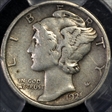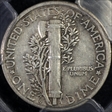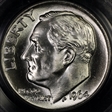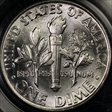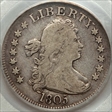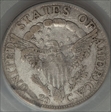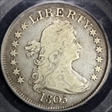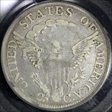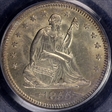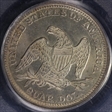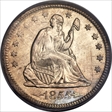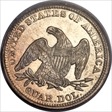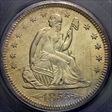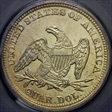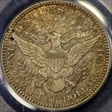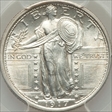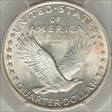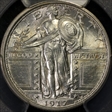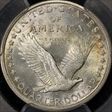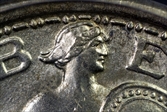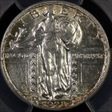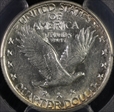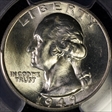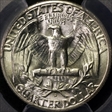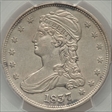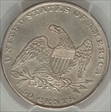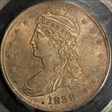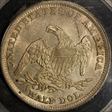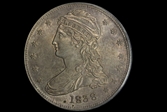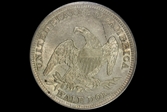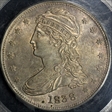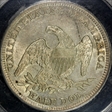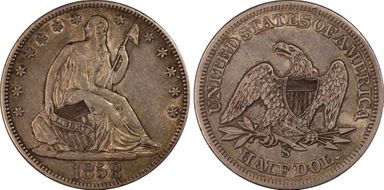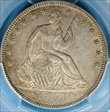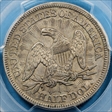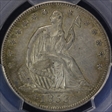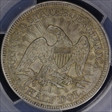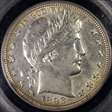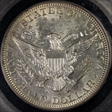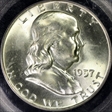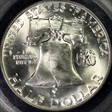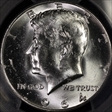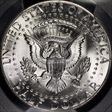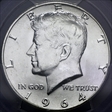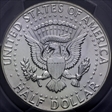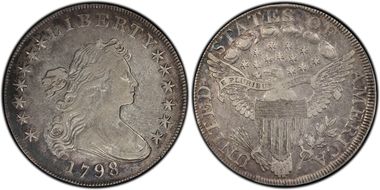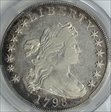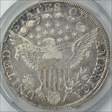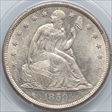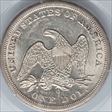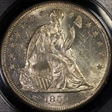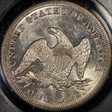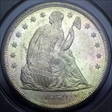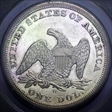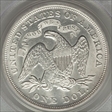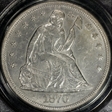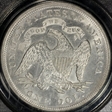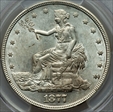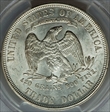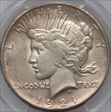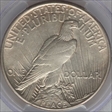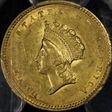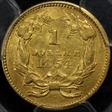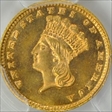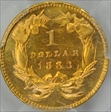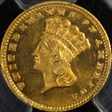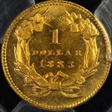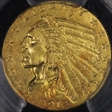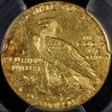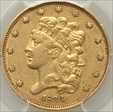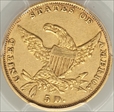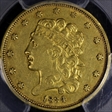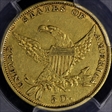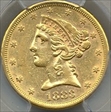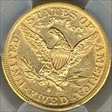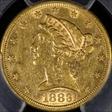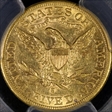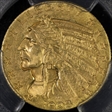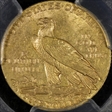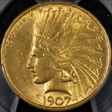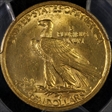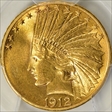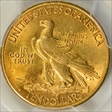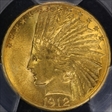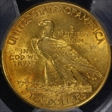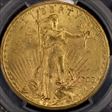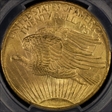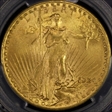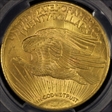The Kankakee Collection 的钱币相册
A medium brown cent with glimpses of lighter mahogany toning. Marks are trivial save for wispy field abrasions near the hair ribbon
A medium brown cent with glimpses of lighter mahogany toning. Marks are trivial save for wispy field abrasions near the hair ribbon
A medium brown cent with glimpses of lighter mahogany toning. Marks are trivial save for wispy field abrasions near the hair ribbon
CAC. This is a high grade example with much underlying glossy luster still evident beneath golden-brown and gunmetal surfaces. Well struck overall and only lightly abraded.Ex: Ramont (2/1995), Jules Reiver Collection (Heritage, 1/2006)(as NGC AU55)
CAC. This is a high grade example with much underlying glossy luster still evident beneath golden-brown and gunmetal surfaces. Well struck overall and only lightly abraded.Ex: Ramont (2/1995), Jules Reiver Collection (Heritage, 1/2006)(as NGC AU55)
Razor-sharp definition shows on the feather tips and diamonds and the lightly toned surfaces of this attractive Gem show only the most insignificant signs of contact. PCGS has graded 27 numerically finer examples
Razor-sharp definition shows on the feather tips and diamonds and the lightly toned surfaces of this attractive Gem show only the most insignificant signs of contact. PCGS has graded 27 numerically finer examples
Razor-sharp definition shows on the feather tips and diamonds and the lightly toned surfaces of this attractive Gem show only the most insignificant signs of contact. PCGS has graded 27 numerically finer examples
Razor-sharp definition shows on the feather tips and diamonds and the lightly toned surfaces of this attractive Gem show only the most insignificant signs of contact. PCGS has graded 27 numerically finer examples
JR-9. The 83 in the date are repunched. This sharply struck and lustrous representative has a brilliant obverse. The reverse displays light olive-green and lavender shades.
JR-9. The 83 in the date are repunched. This sharply struck and lustrous representative has a brilliant obverse. The reverse displays light olive-green and lavender shades.
JR-9. The 83 in the date are repunched. This sharply struck and lustrous representative has a brilliant obverse. The reverse displays light olive-green and lavender shades.
JR-9. The 83 in the date are repunched. This sharply struck and lustrous representative has a brilliant obverse. The reverse displays light olive-green and lavender shades.
Briggs 1-A, showing a die break from the lower left rear of the arrow to the 1 in the date, and die scratches on the reverse above TAT and ME. A curious and interesting example of this type issue, struck from dies that appear to have been axially misaligned, creating a sharp strike at areas near the rims on each side and notable weakness in other peripheral areas. The weakest area of strike on the obverse is 9 to 12 o'clock, and on the reverse 6 to 9. Attractive sandy-gold luster with deeper rose color and a patch of pale blue complement the overall good eye appeal and decent preservation. Population: 18 in 64, 11 finer
Briggs 1-A, showing a die break from the lower left rear of the arrow to the 1 in the date, and die scratches on the reverse above TAT and ME. A curious and interesting example of this type issue, struck from dies that appear to have been axially misaligned, creating a sharp strike at areas near the rims on each side and notable weakness in other peripheral areas. The weakest area of strike on the obverse is 9 to 12 o'clock, and on the reverse 6 to 9. Attractive sandy-gold luster with deeper rose color and a patch of pale blue complement the overall good eye appeal and decent preservation. Population: 18 in 64, 11 finer
Briggs 1-A, showing a die break from the lower left rear of the arrow to the 1 in the date, and die scratches on the reverse above TAT and ME. A curious and interesting example of this type issue, struck from dies that appear to have been axially misaligned, creating a sharp strike at areas near the rims on each side and notable weakness in other peripheral areas. The weakest area of strike on the obverse is 9 to 12 o'clock, and on the reverse 6 to 9. Attractive sandy-gold luster with deeper rose color and a patch of pale blue complement the overall good eye appeal and decent preservation. Population: 18 in 64, 11 finer
Briggs 1-A, showing a die break from the lower left rear of the arrow to the 1 in the date, and die scratches on the reverse above TAT and ME. A curious and interesting example of this type issue, struck from dies that appear to have been axially misaligned, creating a sharp strike at areas near the rims on each side and notable weakness in other peripheral areas. The weakest area of strike on the obverse is 9 to 12 o'clock, and on the reverse 6 to 9. Attractive sandy-gold luster with deeper rose color and a patch of pale blue complement the overall good eye appeal and decent preservation. Population: 18 in 64, 11 finer
Briggs 1-A, showing a die break from the lower left rear of the arrow to the 1 in the date, and die scratches on the reverse above TAT and ME. A curious and interesting example of this type issue, struck from dies that appear to have been axially misaligned, creating a sharp strike at areas near the rims on each side and notable weakness in other peripheral areas. The weakest area of strike on the obverse is 9 to 12 o'clock, and on the reverse 6 to 9. Attractive sandy-gold luster with deeper rose color and a patch of pale blue complement the overall good eye appeal and decent preservation. Population: 18 in 64, 11 finer
Briggs 1-A, showing a die break from the lower left rear of the arrow to the 1 in the date, and die scratches on the reverse above TAT and ME. A curious and interesting example of this type issue, struck from dies that appear to have been axially misaligned, creating a sharp strike at areas near the rims on each side and notable weakness in other peripheral areas. The weakest area of strike on the obverse is 9 to 12 o'clock, and on the reverse 6 to 9. Attractive sandy-gold luster with deeper rose color and a patch of pale blue complement the overall good eye appeal and decent preservation. Population: 18 in 64, 11 finer
A luminous and richly toned example from the first year of the HALF DOL. reverse subtype. Apricot, peach, rose-violet, and blue hues mingle on each side, and a streak of deep toning descends from the word OF to the eagle's right (facing) wing
A luminous and richly toned example from the first year of the HALF DOL. reverse subtype. Apricot, peach, rose-violet, and blue hues mingle on each side, and a streak of deep toning descends from the word OF to the eagle's right (facing) wing
A luminous and richly toned example from the first year of the HALF DOL. reverse subtype. Apricot, peach, rose-violet, and blue hues mingle on each side, and a streak of deep toning descends from the word OF to the eagle's right (facing) wing
A luminous and richly toned example from the first year of the HALF DOL. reverse subtype. Apricot, peach, rose-violet, and blue hues mingle on each side, and a streak of deep toning descends from the word OF to the eagle's right (facing) wing
A luminous and richly toned example from the first year of the HALF DOL. reverse subtype. Apricot, peach, rose-violet, and blue hues mingle on each side, and a streak of deep toning descends from the word OF to the eagle's right (facing) wing
A luminous and richly toned example from the first year of the HALF DOL. reverse subtype. Apricot, peach, rose-violet, and blue hues mingle on each side, and a streak of deep toning descends from the word OF to the eagle's right (facing) wing
1859-O $1 MS60 PCGS. An undeniably Mint State example, this 1859-O Seated Liberty dollar displays fresh, frosty devices set against mirrored fields that show just a touch of light golden toning. Well-struck, with scattered abrasions pursuant to the grade. Housed in a first generation holder.One or more bags of 1859-O and 1860-O Seated silver dollars remained in Treasury vaults until they were released a little over 50 years ago. Today, most low level Mint State examples of these two issues are from that source. This brilliant silver example is likely one of those coins, featuring reflective fields and scattered grade-consistent surface marks
1859-O $1 MS60 PCGS. An undeniably Mint State example, this 1859-O Seated Liberty dollar displays fresh, frosty devices set against mirrored fields that show just a touch of light golden toning. Well-struck, with scattered abrasions pursuant to the grade. Housed in a first generation holder.One or more bags of 1859-O and 1860-O Seated silver dollars remained in Treasury vaults until they were released a little over 50 years ago. Today, most low level Mint State examples of these two issues are from that source. This brilliant silver example is likely one of those coins, featuring reflective fields and scattered grade-consistent surface marks
1859-O $1 MS60 PCGS. An undeniably Mint State example, this 1859-O Seated Liberty dollar displays fresh, frosty devices set against mirrored fields that show just a touch of light golden toning. Well-struck, with scattered abrasions pursuant to the grade. Housed in a first generation holder.One or more bags of 1859-O and 1860-O Seated silver dollars remained in Treasury vaults until they were released a little over 50 years ago. Today, most low level Mint State examples of these two issues are from that source. This brilliant silver example is likely one of those coins, featuring reflective fields and scattered grade-consistent surface marks
1859-O $1 MS60 PCGS. An undeniably Mint State example, this 1859-O Seated Liberty dollar displays fresh, frosty devices set against mirrored fields that show just a touch of light golden toning. Well-struck, with scattered abrasions pursuant to the grade. Housed in a first generation holder.One or more bags of 1859-O and 1860-O Seated silver dollars remained in Treasury vaults until they were released a little over 50 years ago. Today, most low level Mint State examples of these two issues are from that source. This brilliant silver example is likely one of those coins, featuring reflective fields and scattered grade-consistent surface marks
1859-O $1 MS60 PCGS. An undeniably Mint State example, this 1859-O Seated Liberty dollar displays fresh, frosty devices set against mirrored fields that show just a touch of light golden toning. Well-struck, with scattered abrasions pursuant to the grade. Housed in a first generation holder.One or more bags of 1859-O and 1860-O Seated silver dollars remained in Treasury vaults until they were released a little over 50 years ago. Today, most low level Mint State examples of these two issues are from that source. This brilliant silver example is likely one of those coins, featuring reflective fields and scattered grade-consistent surface marks
1859-O $1 MS60 PCGS. An undeniably Mint State example, this 1859-O Seated Liberty dollar displays fresh, frosty devices set against mirrored fields that show just a touch of light golden toning. Well-struck, with scattered abrasions pursuant to the grade. Housed in a first generation holder.One or more bags of 1859-O and 1860-O Seated silver dollars remained in Treasury vaults until they were released a little over 50 years ago. Today, most low level Mint State examples of these two issues are from that source. This brilliant silver example is likely one of those coins, featuring reflective fields and scattered grade-consistent surface marks
WE and STATES are nicely die doubled, one of the few DDR varieties overlooked by Kevin Flynn in his recently published reference to the series. Brilliant and appealing for the designated grade. The strike shows minor softness on portions of the eagle and the right-side stars. Housed in an old green label holder.
WE and STATES are nicely die doubled, one of the few DDR varieties overlooked by Kevin Flynn in his recently published reference to the series. Brilliant and appealing for the designated grade. The strike shows minor softness on portions of the eagle and the right-side stars. Housed in an old green label holder.
WE and STATES are nicely die doubled, one of the few DDR varieties overlooked by Kevin Flynn in his recently published reference to the series. Brilliant and appealing for the designated grade. The strike shows minor softness on portions of the eagle and the right-side stars. Housed in an old green label holder.
10800 minted. 682 PCGS certified, 83 in MS 65. Coinfacts- 65 or better R-5.8
10800 minted. 682 PCGS certified, 83 in MS 65. Coinfacts- 65 or better R-5.8
10800 minted. 682 PCGS certified, 83 in MS 65. Coinfacts- 65 or better R-5.8
10800 minted. 682 PCGS certified, 83 in MS 65. Coinfacts- 65 or better R-5.8
My rarest coin owned by mintage. Just 900 minted, and 146 cert. Although it is estimated 650 survive. This date is one of only three in the series that has an official mintage of less than 1,000 business strikes.
My rarest coin owned by mintage. Just 900 minted, and 146 cert. Although it is estimated 650 survive. This date is one of only three in the series that has an official mintage of less than 1,000 business strikes.
R-6.4 Variety 2-C. With a mintage of only 12,000 pieces, the 1883-CC ten is scarce in all grades and extremely rare in Mint State, with most such pieces showing heavy abrasions. This Choice AU representative is a more affordable alternative. The fields have light chatter but are nonetheless deeply reflective, and the design elements show trivial wear. Bright yellow-gold color blankets each side. Population: 12 in 55, 13 finer. Survival estimate 283, PCGS certified 163
R-6.4 Variety 2-C. With a mintage of only 12,000 pieces, the 1883-CC ten is scarce in all grades and extremely rare in Mint State, with most such pieces showing heavy abrasions. This Choice AU representative is a more affordable alternative. The fields have light chatter but are nonetheless deeply reflective, and the design elements show trivial wear. Bright yellow-gold color blankets each side. Population: 12 in 55, 13 finer. Survival estimate 283, PCGS certified 163
R-6.4 Variety 2-C. With a mintage of only 12,000 pieces, the 1883-CC ten is scarce in all grades and extremely rare in Mint State, with most such pieces showing heavy abrasions. This Choice AU representative is a more affordable alternative. The fields have light chatter but are nonetheless deeply reflective, and the design elements show trivial wear. Bright yellow-gold color blankets each side. Population: 12 in 55, 13 finer. Survival estimate 283, PCGS certified 163
R-6.4 Variety 2-C. With a mintage of only 12,000 pieces, the 1883-CC ten is scarce in all grades and extremely rare in Mint State, with most such pieces showing heavy abrasions. This Choice AU representative is a more affordable alternative. The fields have light chatter but are nonetheless deeply reflective, and the design elements show trivial wear. Bright yellow-gold color blankets each side. Population: 12 in 55, 13 finer. Survival estimate 283, PCGS certified 163




















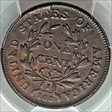
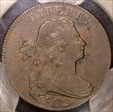
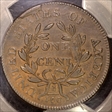
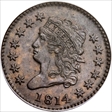
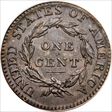
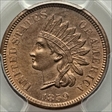
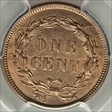
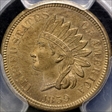
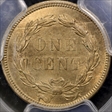
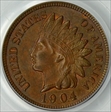
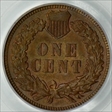
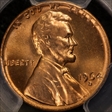
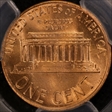
_album.jpg)
_album.jpg)
